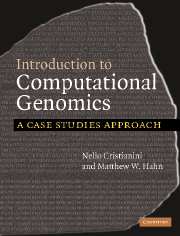Book contents
- Frontmatter
- Contents
- Preface
- Prologue: In praise of cells
- Chapter 1 The first look at a genome
- Chapter 2 All the sequence's men
- Chapter 3 All in the family
- Chapter 4 The boulevard of broken genes
- Chapter 5 Are Neanderthals among us?
- Chapter 6 Fighting HIV
- Chapter 7 SARS – a post-genomic epidemic
- Chapter 8 Welcome to the hotel Chlamydia
- Chapter 9 The genomics of wine-making
- Chapter 10 A bed-time story
- Bibliography
- Index
Chapter 10 - A bed-time story
Identification of regulatory sequences
Published online by Cambridge University Press: 05 June 2012
- Frontmatter
- Contents
- Preface
- Prologue: In praise of cells
- Chapter 1 The first look at a genome
- Chapter 2 All the sequence's men
- Chapter 3 All in the family
- Chapter 4 The boulevard of broken genes
- Chapter 5 Are Neanderthals among us?
- Chapter 6 Fighting HIV
- Chapter 7 SARS – a post-genomic epidemic
- Chapter 8 Welcome to the hotel Chlamydia
- Chapter 9 The genomics of wine-making
- Chapter 10 A bed-time story
- Bibliography
- Index
Summary
The circadian clock
As you step off a trans-oceanic flight into the midday bustle of an airport, your body may be telling you that it's time for bed. This is because our body's sense of time depends as much on an internal clock as it does on external cues. Our internal clock – known as the circadian clock – will eventually synchronize itself with the new day–night cycle, but not before we suffer through the mind-deadening effects of jet lag. Reestablishing a link between the external clock (the sun) and our internal clock is essential for human health. Disruption of circadian rhythms has been linked to mania in people with bipolar disorder, and various health problems manifest themselves more often during the morning (heart attacks) or at night (asthma attacks) depending on our internal clock.
Regulatory regions and sequence motifs
Motif finding algorithms
Combining expression and sequence data
The circadian clock is fundamental to many organisms. Bacteria, insects, fungi, mammals, and many other species maintain an internal clock in order to synchronize their metabolism, activity, and body temperature to the sun. In no other organism is the ability to keep time as important as it is in plants. Much more than in mobile species, plants depend on a steady day–night cycle for energy production: they are able to photosynthesize sunlight during the day to store energy, but must use up these stores at night.
- Type
- Chapter
- Information
- Introduction to Computational GenomicsA Case Studies Approach, pp. 159 - 172Publisher: Cambridge University PressPrint publication year: 2006

